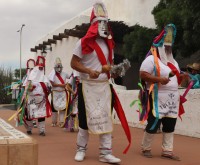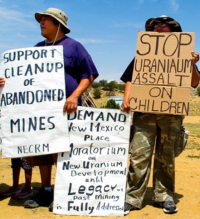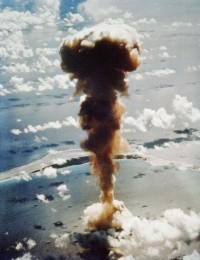Insight on Victims of Nuclear Weapon Use
These are additional resources to learn more about the issues at stake from ongoing nuclear weapons contamination.
This summer, the film Oppenheimer is sparking new interest in the Manhattan Project and prompting questions about the impact and legacy of nuclear weapons use, nuclear weapons testing, and the production of uranium and plutonium. The film entirely omits the voices of people directly impacted by the fallout, contamination, and devastating violence of nuclear weapons use and production.
Trinity Downwinders
Tina Cordova, who co-founded the Tularosa Basin Downwinders Consortium to help secure recognition and resources for downwind victims of the Trinity Test centrally featured Oppenheimer, wrote this powerful opinion for the New York Times, “What Oppenheimer Doesn’t Tell You About the Trinity Bomb Test.”

That fallout has had devastating health consequences. While I know of no people who lost their lives during the test, the organization I co-founded has documented many instances of families in New Mexico with four and five generations of cancers since the bomb was detonated. My family is typical: I am the fourth generation in my family to have had cancer since 1945. My 23-year-old niece has just been diagnosed with thyroid cancer. She is a college student studying art. Now her life, too, has been upended.
Despite this, New Mexicans who may have been exposed to radioactive fallout from Trinity have never been eligible for compensation under the Radiation Exposure Compensation Act, a 1990 federal law that has provided billions of dollars to people exposed during subsequent tests on U.S. soil or during uranium mining.
Pueblo People

The daily radio show Native America Calling hosted an hour-long discussion, “Oppenheimer’s Lasting Nuclear Threat for Tribes.” In the discussion, leaders in Diné, Shoshone, and Santa Clara Pueblo Tribal communities speak of the immense harm to Tribal people and others resulting from the U.S.’ nuclear weapons program. Marissa Naranjo (Santa Clara Pueblo), environmental justice organizer with Honor Our Pueblo Existence (HOPE), told listeners,
Our story is not one that is very uncommon for our Northern New Mexico Pueblo people. I grew up carrying the stories of my great-grandfather and other family members who worked at the (Los Alamos National Laboratory) throughout their lives. I served as a caregiver for four women in my family—my great-grandmother, my grandmother, my great-auntie, and now my mom—all of whom grew up in Santa Clara, helping in farming, making pottery, and other activities where they were really in close relationship with the land. And unfortunately later on in their lives they were all diagnosed with four different types of cancer. So, if you talk to anyone in our Northern Pueblos, they are very likely to have similar stories of family members, especially those in the elder generations, who have similar health challenges, especially related to different types of cancer…
The main message is to be aware, talking to family members, talking to elders, talking to folks who live in that area, and saying that the impacts of (the Los Alamos National Lab) are not just historic, that they are ongoing, that they are legacy impacts, and that it is very needed to have support at all levels of the community—local, state, and federal government—to help address all of these health impacts that are continually ongoing, and the communities who continue to fight every day for peace of mind, the health of their bodies, their minds, and their spirits.
Navajo Nation

Buu V. Nygren, President of the Navajo Nation, recently wrote an Opinion in Time Magazine, titled, “The Navajo Suffered From Nuclear Testing. Oppenheimer Doesn't Tell Our Story.” He writes about the harm caused by nuclear weapons and the production of uranium and other nuclear materials,
Children played in the contaminated water, while livestock drank from radioactive aquifers. What came next—cancers, miscarriages, and mysterious illnesses—is a direct consequence of America’s race for nuclear hegemony. It’s an accomplishment built on top of the bodies of Navajo men, women, and children—the lived experience of nuclear weapons development in the United States. But, as usual, Hollywood chose to gloss over them. The Navajo people cannot afford to be, yet again, erased from history.
Marshallese People

The Marshallese community and government of the Marshall Islands continues to call on the U.S. government to do more to address the pollution, cancer, displacement, and other harm caused by dozens of nuclear weapons tests, most using plutonium produced at the Hanford Nuclear Site. According to the Marshallese Educational Initiative.
From 1946-1958 the United States detonated 67 nuclear weapons on Bikini and Enewetak Atolls in the Marshall Islands, which resulted in forced relocation, culture loss tied with loss of lands, as well as biological and ecological consequences, which are ongoing. Despite the importance the Marshall Islands played in the United States’ rise to Superpower status in the early years of the Cold War, this shared nuclear legacy is not found in U.S. history textbooks and rarely acknowledged.
ABC News recently reported, “America's forgotten nuclear migration: The Marshallese displaced by US bomb testing face new challenges.”
Jonithen Jackson remembers the stories his mother and grandmother used to tell him before bed, Marshallese folk stories teaching lessons of hope and kindness. Embedded in these stories, Jackson tried to understand why his people couldn’t live on their home island anymore. “Everybody's sick; they get sick and die young,” Jackson told ABC News. “When the bomb is erupted, the white powder they come to on the water… everybody realize, ‘oh, that's the poison." Jackson’s home island is Enewetak Atoll, where the United States tested 43 nuclear bombs from 1948 to 1958.
Remembering Hiroshima
Hidehiko Yuzaki, Governor of the Hiroshima Prefecture in Japan, penned an opinion for the San Francisco Chronicle titled, “Here’s what Oppenheimer means to me.”
While Oppenheimer is history, nuclear weapons are not. As audiences absorb Hollywood’s take on the man behind the bomb, I hope they also will consider how nuclear weapons have held our planet and its people hostage for more than three-quarters of a century and how the risks they pose today may be greater than ever before…I can tell you that generations later, we still feel the impact of those two bombs.
Will Congress Step Up?
On July 28, 2023, after more than a decade of advocacy by the people in the Tularosa Basin Downwinders Consortium, Navajo Nation, and the Santa Clara Pueblo Tribe, and many others, the U.S. Senate approved by an 86-11 vote an amendment that would expand the Radiation Exposure Compensation Act (RECA) to include more people harmed by the production and testing of nuclear weapons in the U.S. However, the amendment is not yet included in a House-approved defense bill as the two chambers negotiate the final legislation.
Additionally, Congressman Earl Blumenauer is an original co-sponsor of HR 77, which calls on the President to embrace the goals and provisions of the Treaty on the Prohibition of Nuclear Weapons and make nuclear disarmament the centerpiece of U.S. national security policy. It also calls on the United States to lead a global effort to move the world back from the brink of nuclear war and to prevent nuclear war. Congress has not yet supported H Res 77.


